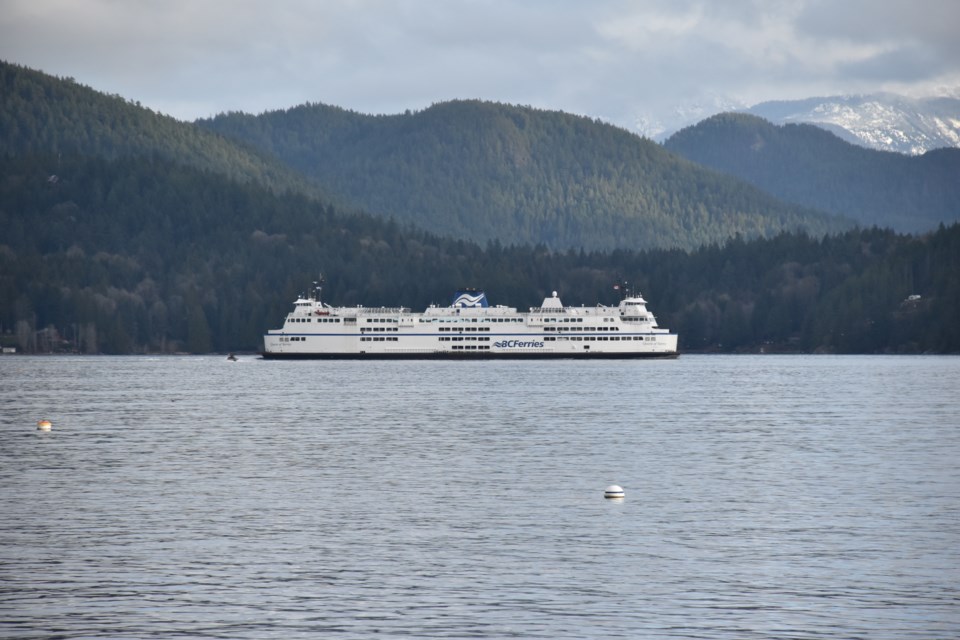The Southern Sunshine Coast Ferry Advisory Committee met Jan. 17 for its first meeting of 2022. The following are briefs from that meeting.
Saver fare
BC Ferries has extended the Route 3 saver fare pilot through to the end of March. The pilot program offers a discount for users who reserve spots on less busy sailings (evenings, after 9 p.m.) The percentage of reservations on evening sailings rose to 30 per cent in the trial period – up from 10 per cent in 2019. Fifty four per cent of respondents to a BC Ferries survey noted that this deal will influence how they travel with the ferry service in the future.
“It may not solve the entire problem, but it will certainly help to alleviate pressure on some of those peak sailings,” Brian Anderson, BC Ferries’ vice president of strategy, said of the pilot program.
Queen of Surrey retrofit
The Queen of Surrey is leaving for a nearly two-month retrofit on Feb. 7. The Queen of Coquitlam will fill in over that period. The retrofit includes engine room maintenance and equipment upgrades on the bridge.
Horseshoe Bay parkade
After a rockfall closed the parkade earlier this month, BC Ferries is working on getting the rock removed and doing some repair work on the concrete. The rock debris damaged one pillar and some of the deck work. They don’t have a firm timeline for reopening but they think it’s about a month, Doug Hanning, BC Ferries’ regional manager for terminal operations, said. Parking is available in the surface lots with the possibility of an overflow lot up at the golf course, should that be necessary, but it hasn’t been yet, indicated Hanning. All of the cars that were in the parkade have been moved.
Two-ship service
The two-ship service is returning to Route 3 June 23 to Sept. 5 – allowing for a more robust summer sailing schedule, except on Tuesdays and Wednesdays.
A year-round two-ship service, though, apparently isn’t in the near-term cards.
“It's been made very clear that residents and users of the route would like to see that level of frequency in place longer,” said Anderson. If Route 3 were to see such a service, BC Ferries would be looking to get another ship, which takes time to build, said Anderson. A ship ordered now would take five to seven years to get here, he indicated later in the meeting.
“It is a huge issue,” said FAC chair Diana Mumford. “We need more service. So hopefully, that continues to resonate with [Ministry of Transportation and Infrastructure].”
Kirk Handrahan, executive director of the marine branch of the Ministry of Transportation and Infrastructure, pointed to the money that was spent to maintain service levels during the pandemic and the challenges facing BC Ferries and the province.
Service contract
For FAC members, however, the service contract between the province and BC Ferries for Route 3 is an ongoing point of consternation.
“We are currently at a service level that's above the contract. So the absolute minimum ask is to amend that contract to actually specify the amount of service level that we're [getting],” said FAC member Matt McLean. “We want to see that written down. And I want to see that transfer coming from the province to BC Ferries to pay for Route 3.”
Handrahan said that it’s a “complex thing.” He noted that BC Ferries and the ministry would have to have discussions around sustainable service levels. “We want to make sure that if we're changing the contract, we can sustain it,” said Handrahan.
Though there have been a few changes, the contracts between BC Ferries and the province are pretty similar to what they were when put out in 2003, said Mumford. “That was 19 years ago. And ferry traffic has changed dramatically since that period.
“As ferry users, we’re asking and pushing for changes to more accurately reflect the usage of the ferry system,” said Mumford. “We are ferry-dependent communities, those are our roads.”
FAC member Lori Pratt wondered what the critical mass was for utilization rates to get the service level contract to change.
Government has many challenges and doesn’t have unlimited money, said Handrahan. “So I need a really compelling case.”
“We've got that information. We're working on it. And the best we can do is bring it forward and see if we can get it.”
Resident priority boarding
“This is one that keeps coming up,” said Mumford.
“This is not a decision BC Ferries can do unilaterally,” she said – it would need to come through ministerial direction. “What we were told by [Transportation and Infrastructure] Minister Fleming was that as this is using public funds that go into ferries, that they wouldn't be prioritizing any one person over another.”
In discussions last summer, the FAC chairs couldn’t come to the consensus that the issue should move forward, said Mumford.
There is, however, still a ministerial order still in place giving medically assured sailing, which allows residents to get a letter from their doctor that allows them to travel on the next available sailing.
Terminal congestion
The congestion in Horseshoe Bay over the past couple of summers came up. Mumford requested a meeting between terminal operations and the three Sunshine Coast FACs (Gambier-Keats and Northern Sunshine Coast).
“We don't want to go through another summer like that,” said Mumford.
The terminal has been running over capacity for the last couple of years and it’s been a challenge to manage the amount of traffic coming through, said Hanning. He agreed to meet with the FACs and hear their ideas.


.jpg;w=120;h=80;mode=crop)
